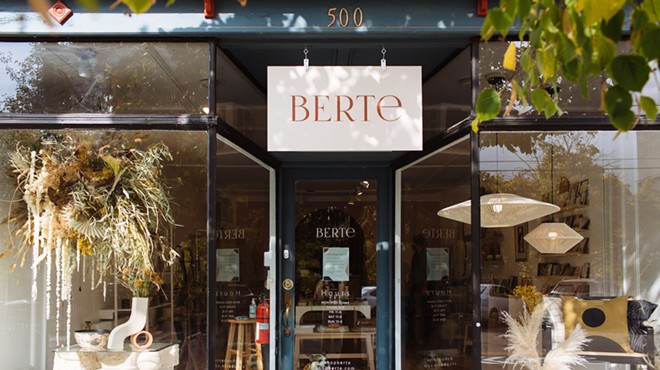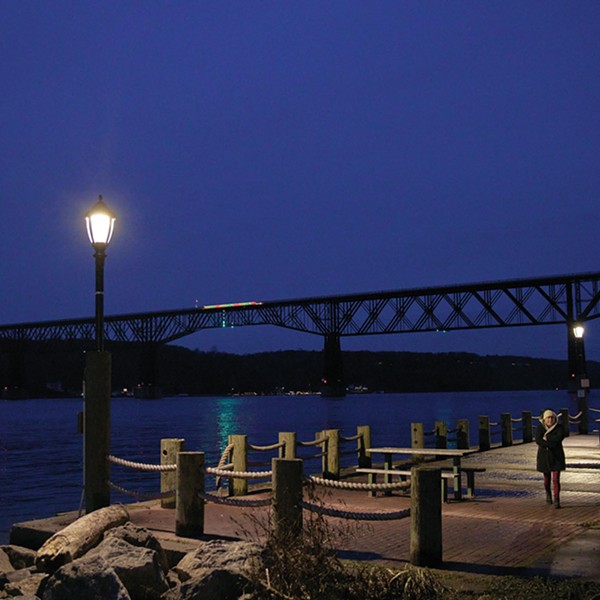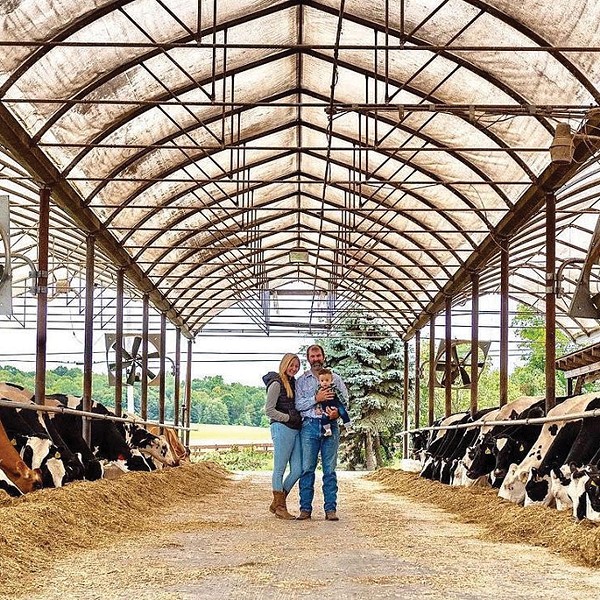There’s never only one beginning.
It’s 1913. The villages of Fishkill Landing and Mattewan have grown prosperous and, as fate would have it, into each other. There’s not a whole lot of extra room here, nestled in-between a curve in the Hudson River and the slopes of Mount Beacon, so it was only a matter of time before their Main Streets met in the middle and the two towns became one. After some heated discussion and false starts, they name their new city after the mountain that shields them from southern storms.
It’s 1987. The Hudson River city of Beacon, after decades of factory closings and urban renewal projects that laid whole neighborhoods low, has seen better days. People drive through town with their doors locked and their windows rolled up. But folk icon Pete Seeger is still here, sailing with the good sloop Clearwater and fighting for a cleaner Hudson River. Rent is cheap and the buildings have good bones. Antique stores spring up. And in a studio on Maple Street, a glass-blowing studio called Hudson Beach Glass opens.
It’s 2003. An old brick firehouse on Main Street becomes the new home of Hudson Beach Glass, and soon artists are meeting there. The meetings get bigger, they start putting up shows, drawing up plans, stirring the pot, producing a potentially explosive brew. Then the Dia Art Foundation swings into town like a lit match, takes a look at an old Nabisco factory down by the river, and “Kaboom!” Next thing you know, the train station platform is packed with international tourists, all of whom have fiercely held opinions about Richard Serra.
There’s never only one beginning, I think to myself in 2007 when I move to Beacon. Dia:Beacon has been open for four years. “Beacon is back!” people tell me, but half of Main Street is still boarded up and there’s only a single B&B to accommodate the many new tourists. I buy a couch from a woman in town, and her son, a student at SUNY New Paltz, drops it off. “Why would anyone want to live here?” he asks me. “Everything closes at 8pm and there’s nothing to do.”
It’s 2011. The Roundhouse opens in one of the abandoned factories: a hotel with a stylish bar and restaurant overlooking a waterfall. I walk by it the night it opens as a tastefully dressed older couple walks out of it. “Well I guess we’re going to be people who go out at night now,” the man tells his wife.
The Towne Crier moves into the long-empty, low-slung shell across from the post office. Quinn’s transforms from a cash-only breakfast spot into a ramen and free jazz bar. Rickie Lee Jones is playing up the block one week, Mdou Moctar down the block the next. There are three places where you can drink beer 10 feet away from where it was brewed (Two Way, Industrial Arts, and Hudson Valley Brewery), two places where you can drink coffee 10 feet away from where it was roasted (Trax and Big Mouth Coffee), and one place where you can drink coffee while covered in cats (Beans Cat Cafe.)
It’s never just one poetry reading or book written or museum opening or back room meeting or amp plugging in that starts it all off. One thing leads to another, which leads to another, and then, one night, as Emily Murnane tells me, you find yourself walking down Main Street in the middle of the night by yourself without thinking twice about it.
Murnane knows more than most what Beacon’s been through. A lifelong resident, she’s taught in the public school system here and currently serves on the board of the Beacon Historical Society. Her father moved here in 1978, started serving on the Volunteer Ambulance Corps, and can tell you some hair-raising stories about what the city was like back then. But now, Murnane tells me, she can walk into any part of town, any hour of the day or night, and feel as safe as if she were standing in her front yard.
There’s a catch, though, which Murnane knows all too well, having seen who has had to leave Beacon in recent years as the town changes. “It’s a wonderful thing to feel safe in your own home,” she says. “I just hope everyone in town gets to feel that way.”
Building Abundance
There’s a feeling, says city council member Dan Aymar-Blair, that the success of Beacon hasn’t worked out so well for everyone who lives here. “It’s only worked for the people who were able to make investments related to the resurgence,” he says. Even before the pandemic jokerized the entire country’s real estate market, Beacon’s rental and housing market had transformed from “robust” to “bonkers.”New luxury housing units on Main Street, built higher than any other buildings around them, helped nudge the market even further out of reach for many and have been a convenient scapegoat to point to when anyone starts grumbling about what’s wrong with Beacon today. On one hand, it’s probably unfair to blame every single recent ill on a few four-story buildings. On the other hand when, after the first snowstorm this winter, two of those buildings were the only ones along Beacon’s mile-long Main Street that didn’t shovel their sidewalks. A lot of people noticed and drew their own conclusions.
This has led to the impression that Beacon is anti-development, which Aymar-Blair says isn’t exactly true.
“I don’t think there’s a lot of people out there that are opposed to actual construction,” he says. “Usually the questions I hear are: Why does it look so awful and out of place? Why is it so ugly and big? Why doesn’t it have any affordable housing in it?”
There’s more than aesthetics at stake. One might think that years of new construction would lead to a massively growing city, but initial 2020 census numbers show the opposite is true: The population actually shrank 11 percent in the past 10 years, and the city’s Black population was hit particularly hard, dropping by 47 percent. Until more detailed data is released, it’s hard to know exactly what to make of this. Initial analysis suggests that the census may have included the population of the recently closed Fishkill Correctional Facility, which lies partly in Fishkill and partly in Beacon, as part of Beacon in the 2010 census and Fishkill in the 2020 census (Fishkill grew by 10 percent in the past decade.) Residents identifying as multi-racial also increased by 129 percent, which may partly explain the decrease in Beacon’s Black population, as the 2020 census asked different questions about race than the 2010 census did and tabulated the results differently.
But the decrease matches anecdotal accounts of those who’ve noticed the city’s Black population shrink in the past 10 years. The shift was noticeable to Murnane in her years teaching in Beacon’s schools, as she saw which students had to move away and which didn’t.
It’s also been noticeable to Reverend Ron Perry Sr., of Beacon’s Springfield Baptist Church. The church is one of the oldest in Beacon, and once served as a stop on the Underground Railroad. But Rev. Perry told me that over the past decade, much of his congregation has had to move out of Beacon, coming from as far away as Poughkeepsie and Hyde Park, before eventually leaving the state altogether. To him, this points to a statewide problem, as opposed to a Beacon problem. “New York State has priced a lot of people out, not Beacon,” he says.
Affordable housing is needed, but what exactly qualifies as “affordable?” Aymar-Blair goes by the federal definition, which says that no more than 30 percent of one’s income can go towards housing. “To truly create affordable housing for people of every income range, we need to have housing that’s available at 30 percent of those different income levels,” he says. Beacon’s in good shape at the bottom level, with large amounts of subsidized housing. And all the new luxury housing takes care of the top end. “But we need to plug in a lot of gaps in between,” says Aymar-Blair.
The job market may be booming, but what happens if you’re in Section 8 housing in Beacon, you get a new job that pays significantly more, but now you make too much to continue to qualify for subsidized housing? “I have a choice of taking a higher-paying job and moving out of Beacon because of the lack of available housing at that price range, or I have to turn the job down so I can stay in my home,” says Aymar-Blair. “We need to look at those kinds of scenarios and make sure that there’s sufficient housing stock for people at all income levels.”
In order to do that, the city can increase the amount of affordable housing it requires developers to have in any building with 10 or more units. The city is also looking at the amount of public land it owns and which lots would be good candidates to offer to developers who will build low-income and affordable housing.
Beacon also recently became one of the few cities in the state to pass a Good Cause Eviction law, which places some limitations on rent increases and stipulates that landlords can’t evict tenants without a good reason. The law remains controversial; the city’s own attorney advised against it because landlords in Albany recently sued that city after their Good Cause law was passed. What happens with the Albany lawsuit will determine what happens in Beacon and elsewhere while New York considers enacting a statewide version of the law. In the meantime, Aymar-Blair said that even if Beacon gets sued, it’s worth the legal fees if it means people can stay in their homes and communities don’t continue to get ripped apart.Together, these actions will hopefully ensure that everyone who wants to stay in Beacon can stay in Beacon, especially since some of the upsides of the city’s development boom will soon be apparent. The revenues created by the new developments funded a badly needed overhaul of the city’s ancient wastewater and sewage systems, which were at their breaking points. Every Beaconite who thinks all the new buildings look like crap can thank those buildings for making sure their own basement doesn’t soon become flooded with crap.
The city has an ambitious list of possible projects to consider: A new community center, to replace the two that closed years ago, is a frequent public demand. Also being discussed: new sidewalks on roads that don’t currently have them, more public bathrooms, more public spaces on Main Street, municipal composting, upgrades to the city’s parks, and more greenway trails. “The idea is, you take all the money from the new development, and you use it to improve the lives of everyone who lives here,” says Aymar-Blair.
And those still coming. Even a cursory walk down Main Street shows that for a lot of people, the pandemic was a new beginning.
The New Class
It’s 2020 and Nikki Hayes has just lost her job. She hated working behind a computer anyway.What she loved about her design job were the parts when she got to work with her hands and be creative. She decides that it’s time for a change, and if it doesn’t happen now, it’s never going to happen. She looks at what she loves—cooking, design, supporting small businesses owned by women—and sets her sights on opening a store in Beacon selling artisanal, small-scale grocery products and cookbooks. She knows that the store has to be in Beacon, because she loves Beacon. She lives close by, and she and her husband always come here on their days off to walk down Main Street. “Why would I go anywhere else?” she says. “I don’t feel comfortable anywhere else.”
Unfortunately, everyone else has had the same idea, so it takes a year and many near-misses before she is able to open Stella’s Fine Market, a provisions shop on the west end of Main Street named after her daughter, in December 2021. “This is like a dream, like a Nancy Myers movie,” she says. The store is small, but for anyone who enjoys food and/or design, it’s a place one can spend a lot of time. The shelves groan with Fat Gold olive oil, Fly By Jing chili crisp, Rancho Gordo beans, and copies of the feminist food magazine Cherry Bombe.
Stella’s joins an impressive new crop of stores that have opened in Beacon in the last two years. Some of them, like Momo Valley, were a long time coming. The Tibetan restaurant started years ago as freezer bags of their homemade frozen dumplings being sold out of Beacon Natural Market. That led to sometimes selling food during busy nights at Hudson Valley Brewery, to a booth at the new Beacon Food Hall, to their own restaurant on Main Street.
Nearby, the sustainable bulk retailer Refill Restore has just opened up, a long overdue place where Beaconites can buy cleaning products and other home goods in bulk without the packaging. The award-winning chocolatier Hakan Martensson has opened up his namesake store of astonishing handmade bonbons and baked Swedish treats.
Twenty-year-old cookbook author and vegan activist Halie Thomas opened up the Matcha Thomas tea house with her family. The business grew to be so popular in the first few months that they’ve already moved to a bigger space. Little King opened last year as both a cafe and a homeware store with an impressive selection of food-adjacent zines on the shelves as well.
“Beacon is very community oriented, but it’s also very future oriented,” says Aimee deSimone of Berte, the handmade design shop she opened in October of 2020. Before opening the store, deSimone worked in television production, which involved a lot of traveling around the country and shooting B-roll of various main streets. So it carries particular weight when she says that Beacon’s mile-long Main Street sticks out. “I’ve never seen anything like it,” she says.
As the nation approaches the end of—or a lull in—the pandemic, the city’s new residents are emerging from their homes and searching for community. DeSimone hit on the idea of having a monthly event to get locals out and onto Main Street. Last month, local businesses kicked off First Fridays to complement Beacon’s long-running arts-focused Second Saturdays. The city’s galleries usually have their openings on the second Saturday of the month, so that people can walk around town and check out all the shows in one day. First Fridays serves a similar function, only with raffles, giveaways, extended hours, sales, and other surprises. “It’s a choose-your-own-adventure kind of night,” said deSimone. “One store had you flip a coin, and if you guessed right, you got a discount.”
“It’s great that there’s so much love coming back into the city,” says Murnane, who says that at the Beacon Historical Society there’s something they call “the Beacon Magic.” Someone, after years of wanting to move to the city or open a business here, finally makes it happen. Then they come into the historical society to learn about their new home or storefront and discover that they have long-lost family that used to live here, or that a store very similar to theirs was operating out of the same space 100 years ago. “You almost get the sense that this city is drawing in missing pieces and reassembling them,” she says. “When people put those connections together, there’s this burst of love and pride that comes out of them.”
You can see the effects of this love and pride that Beaconites continue to have for their city after a particularly rough few years through the care and mindfulness that people are bringing to their new stores, their new projects, their new dreams for the future. “People come to this town and they can’t help but fall in love with it,” she says.
It’s 2022. Scenic Hudson is holding public meetings going over the details of its new Fjord Trail, an ambitious multi-year project that will build a riverside trail from Beacon to Cold Spring. A new hotel and concert venue is planned for a closed church near City Hall, as well as the restoration of the church’s historic graveyard. Someone who just moved to the city is walking down Main Street and realizing, for the first time in a long time, that they finally feel at home. There’s never only one beginning.















